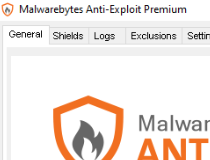

- #Malewarebytes anti exploit how to
- #Malewarebytes anti exploit windows 10
- #Malewarebytes anti exploit windows
I still believe that EMET can provide value by adding mitigations to commonly used applications both for enterprise/business users and individual user applications when those applications don’t include mitigations such as DEP or ASLR etc. While EMET is still supported I will recommend its use but will note that its end of support date is approaching. You recommend EMET a lot on this blog is that going to change? Moreover it can impact their reliability since it hooks into the operating system at a low level in order to add its protection to the applications chosen by a system administrator or individual user.

In addition, Microsoft mentioned that EMET can reduce the performance of the applications that it protects.
#Malewarebytes anti exploit windows
In addition in their most recent blog post concerning EMET Microsoft states that EMET’s effectiveness against modern exploit kits (defined) has not been proven and were not designed to be a long term solution just a “stop gap” to add extra protection to older versions of Windows without necessitating upgrading to a newer version of Windows. While a competitor to EMET, SurfRight HitmanPro.Alert mitigated the WoW64 bypass, Microsoft never incorporated such changes (or at least never documented such improvements). Why Should This Announcement Be Considered Important?Īt this time there are known bypasses for EMET e.g. The final support deadline is now the 31st of July 2018 (originally 27th January 2017). Thank you.Įarly last week Microsoft extended the support deadline of their exploit mitigation tool, Enhanced Mitigation Experience Toolkit (EMET). I hope that you find this additional information useful. How the CERT/CC team align to the US CERT team is mentioned in this Sophos blog post.
#Malewarebytes anti exploit windows 10
That post also provides a comparison table of Windows 7 and Windows 10 with and without EMET to better display the benefits EMET offers. The CERT blog post also provides the steps to enable system-wide DEP an ASLR if EMET (or the alternatives) cannot be used. If this is not the case, the alternatives discussed above could be considered. This is of course assuming that future builds/versions of Windows 10 allow EMET to continue to function. They recommend using EMET on Windows 10 after the end of support deadline in July 2018 to protect applications that do not incorporate security mitigations. Once again shortly after publishing this post, I came across this blog post from the CERT/CC team of Carnegie-Mellon University. Though we’re aware that this GPO presents some UX challenges, we’re actively working to improve our mitigation management experience for future releases. These mitigations include DEP, SEHOP, Mandatory/Force ASLR, and Bottom-up ASLR. Today, the Process Mitigation Options GPO documented below can be used to configure certain in-box Windows 10 mitigations for particular processes. Thank you for your support and for providing this helpful feedback! We will consider these suggestions as we develop our documentation and continue to evolve our security and mitigation features in future releases of Windows 10. I have provided the text of their message below. From their message there appears to be a possibility that further mitigations will be available in later updates to Windows 10. While the above mitigations don’t provide the same level of protection that EMET offered, they offer an improvement over not using them. They also mentioned this GPO should be receiving further usability improvements in the future. This can be used to apply mitigations such as DEP, SEHOP, Mandatory/Force ASLR, and Bottom-up ASLR to a process without using EMET. They suggested using the Process Mitigation Options GPO which is described in the link provided by them below. These can be used with any applications, not just legacy applications.
#Malewarebytes anti exploit how to
Shortly after publishing this blog post, I received a response (apologies for not posting this update sooner) from the Microsoft EMET team to some questions that I had asked with regard to how to harden applications that do not incorporate security mitigations be default on Windows 10 once EMET has reached it’s end of support. Further details are available in the above mentioned blog post. This makes sense for version 1709 since it includes a replacement for EMET while 1703 (to the best of my knowledge does not).Īs noted in a new blog post, an upcoming update to Windows 10 will contain some features of EMET. Versions 17 of Windows 10 will block the installation of EMET.


 0 kommentar(er)
0 kommentar(er)
